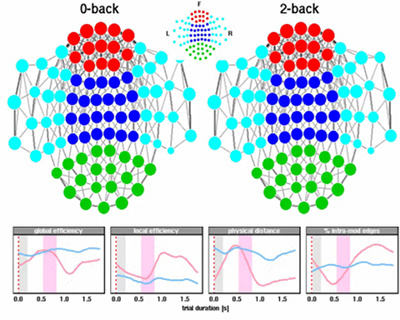Dynamical workspace reconfiguration under cognitive load
Duration: 2 mins 7 secs
Share this media item:
Embed this media item:
Embed this media item:
About this item

| Description: |
A movie of dynamic network changes during performance of zero- and two-back working memory tasks.
Bottom row, Changes in key workspace parameters as a function of trial duration for zero-back (red lines) and two-back (blue lines) versions of the task: from left to right, global efficiency, local efficiency or clustering, physical distance, and proportion of intramodular edges. Red bar, Interquartile range of response latencies. L, Left; R, right; F, front. |
|---|
| Created: | 2013-10-28 14:52 |
|---|---|
| Collection: | Brain network dynamics |
| Publisher: | University of Cambridge |
| Copyright: | Manfred G. Kitzbichler |
| Language: | eng (English) |
| Distribution: |
World
|
| Keywords: | Neuroscience; Brain imaging; Networks; Working memory; Cognition; |
| Explicit content: | No |
| Aspect Ratio: | 4:3 |
| Screencast: | No |
| Bumper: | UCS Default |
| Trailer: | UCS Default |
| Abstract: | Cognitive Effort Drives Workspace Configuration of Human Brain Functional Networks
Manfred G. Kitzbichler, Richard N. A. Henson, Marie L. Smith, Pradeep J. Nathan, and Edward T. Bullmore The complete journal article (DOI:10.1523/JNEUROSCI.0440-11.2011) can be found at: http://www.jneurosci.org/content/31/22/8259.abstract Abstract: Effortful cognitive performance is theoretically expected to depend on the formation of a global neuronal workspace. We tested specific predictions of workspace theory, using graph theoretical measures of network topology and physical distance of synchronization, in magnetoencephalographic data recorded from healthy adult volunteers (N = 13) during performance of a working memory task at several levels of difficulty. We found that greater cognitive effort caused emergence of a more globally efficient, less clustered, and less modular network configuration, with more long-distance synchronization between brain regions. This pattern of task-related workspace configuration was more salient in the β-band (16–32 Hz) and γ-band (32–63 Hz) networks, compared with both lower (α-band; 8–16 Hz) and higher (high γ-band; 63–125 Hz) frequency intervals. Workspace configuration of β-band networks was also greater in faster performing participants (with correct response latency less than the sample median) compared with slower performing participants. Processes of workspace formation and relaxation in relation to time-varying demands for cognitive effort could be visualized occurring in the course of task trials lasting <2 s. These experimental results provide support for workspace theory in terms of complex network metrics and directly demonstrate how cognitive effort breaks modularity to make human brain functional networks transiently adopt a more efficient but less economical configuration. |
|---|---|
Available Formats
| Format | Quality | Bitrate | Size | |||
|---|---|---|---|---|---|---|
| MPEG-4 Video | 900x720 | 2.88 Mbits/sec | 45.84 MB | View | Download | |
| MPEG-4 Video | 450x360 | 1.82 Mbits/sec | 28.99 MB | View | Download | |
| WebM | 900x720 | 2.48 Mbits/sec | 39.76 MB | View | Download | |
| WebM | 450x360 | 744.92 kbits/sec | 11.64 MB | View | Download | |
| iPod Video | 480x360 | 405.69 kbits/sec | 6.29 MB | View | Download | |
| MP3 | 44100 Hz | 250.59 kbits/sec | 3.88 MB | Listen | Download | |
| Auto * | (Allows browser to choose a format it supports) | |||||

